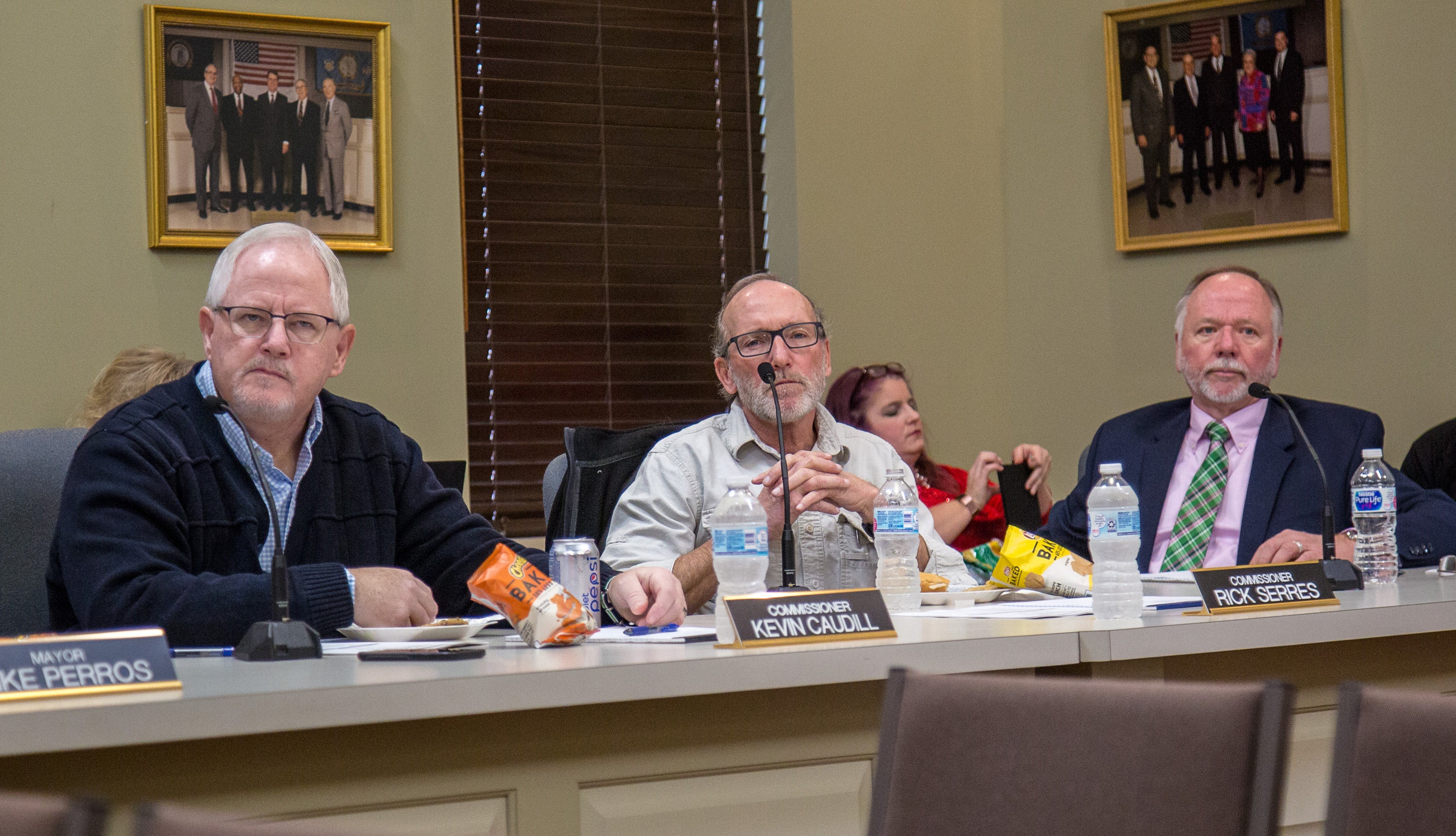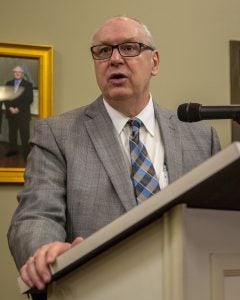Danville investigates possibility of ‘tax-increment financing’
Published 8:13 am Friday, February 16, 2018

- From left, Danville commissioners Kevin Caudill and Rick Serres and City Manager Ron Scott listen to information about TIF districts from consultant Jim Parsons Wednesday. (Photo by Ben Kleppinger)
Danville City Commission gathered for a special workshop session this week to learn about the economic development possibilities of tax-increment financing districts.
Tax-increment financing (TIF) is technical language for a relatively simple concept, which TIF district expert Jim Parsons laid out for commissioners over lunch Wednesday.
TIF districts allow city and county governments to designate geographic areas where growth in tax revenues will be put toward an economic development project, Parsons said.
TIF districts are used around the nation and across Kentucky to incentivize developers, build spaces for public use and more. Notable TIF-district developments in Kentucky include the YUM Arena in Louisville and the Ark Encounter attraction in Williamstown, Parsons said.

Consultant Jim Parsons explains the basics of TIF districts to Danville City Commission members Wednesday. (Photo by Ben Kleppinger)
“A TIF (district) doesn’t create any property restrictions, it doesn’t create new zoning, it doesn’t place any new taxes (except optional payroll taxes Danville doesn’t seem likely to consider) … it doesn’t create any tax exemptions. The property owners within a TIF district will not even know they are in the TIF district. They will pay taxes exactly like they would (if there was no TIF district,” he said. “The taxpayer really has no idea. It really just is a mechanism to allow the local government creating the TIF district to use a portion of those taxes that are generated to promote projects.”
The basics
“If you created a TIF district and you generated $100 (in tax revenues) the base year, if at the end of the next year you have generated $200, then you have an increment of $100 that can be pledged to support a project,” Parsons said.
Legally, cities, counties and most special taxing districts can contribute up to 100 percent of new tax revenues to a project.
But “most communities would never pledge 100 percent of their increment, unless there’s some special deal,” Parsons said. “You can legally pledge 100 percent, but it doesn’t make sense to do so unless there are very special circumstances, because ultimately you need some of that increment for city services.”
Parsons offered the Ark Encounter project in Williamstown and Grant County as an example: “The city and county are both participating. The city and county just reimburse the developer on an annual basis 75 percent of the incremental increase in taxes. And it’s not required to be accounted for to infrastructure or anything. It’s just a direct reimbursement of project costs.”
Parsons said the funds contributed to a TIF district must be spent on economic development or tourism, but those broad categories allow for a wide variety of choices.
“I know all this has been vetted legally in every way possible, but we’ve always been under the impression that as a municipality, we can’t favor a private entity, a for-profit entity,” Mayor Mike Perros said.
“You actually — in a sense, you can,” Parsons answered. “… You’re required to spend public tax dollars for a public purpose. But promoting economic development is a public purpose. So therefore, it doesn’t mean it has to be for a public project, necessarily.”
Parsons said there are lots of court cases that say “you can spend public tax dollars, even on a private business, if it’s for a public purpose. … I can provide you with some case law on that.”
“Legally you can do it,” he said. “Now from a policy standpoint, you may want to limit how you use the revenues — that’s totally up to you. But from a legal standpoint, as long as you’re expending the tax dollars for a public purpose, and that purpose is economic development, then you can do that.”
Other TIF options: TIF funds can be used to pay on bonds taken out to finance a project, though that should be done carefully, Parsons noted. A downtown TIF district could grow slowly over time and the funds could eventually be used to improve a downtown space. TIF funds could also be used to build roads and infrastructure to support private development projects.
Cities and counties can pledge TIF district funds for up to 30 years.
Commissioner Kevin Caudill asked if a TIF district could be done away with if something changes; Parsons said as long as the TIF funds aren’t pledged to pay off a debt, the district can be terminated at any time.
Parsons said TIF districts are typically more successful if a city, county and their special taxing districts can work together to all pledge a portion of their tax revenue growth.
“If you can partner with your county government. It strengthens the whole deal,” he said.
Danville’s interest
Why is Danville interested in TIF districts? City commission members said it’s all about economic development.
“I think it’s time we think outside the box. And this to me is outside of the box from what we’ve done in the past,” Commissioner Denise Terry said. “… planning is important; while we are planning, we need to think outside of the box.”
Danville Mayor Mike Perros suggested a pair of hypotheticals: A TIF district for significantly enhancing the area around Constitution Square; and using a TIF district to help the Boyle Landmark Trust fund its revolving fund for restoration of historic buildings. Parsons said both would be possible.
After completing Parsons’ primer on TIF, Perros said, “What this really screams to me is it’s time that we did some serious long-term professionally done planning.”
Parsons said that may or may not be the case.
“Sometimes you don’t need a real, exact plan like that. But depending on how large the area is or whatever, it might be helpful,” he said.
Parsons said the city of Union created a town plan but couldn’t get it built because it was too ambitious.
“A lot of that property has sat vacant simply because no developer can meet the requirements of the town plan because it didn’t make any sense when it was done,” he said.
Parsons said many TIF district projects are “developer-driven” — a developer comes to a government with a proposal for a TIF district. Others are government-driven: A city and/or county identifies an area in need to revitalization or redevelopment and creates a TIF district hoping to attract developers.
Once Danville has picked out an area it would like to see re-developed, Parsons said the city will have to answer some questions:
“How important is the development of that site? How long are you willing to wait for it to be developed without some type of incentive? Do you believe it would ever be developed without some type of assistance? And if it is developed without some type of assistance, will that project be what you want?” Parsons asked. “Because a lot of times, a developer could come in and meet your zoning code and be entitled to get a building permit or whatever, but it may not be a project that you want. So when you do partner with a (developer), you have a little bit more control … since you have some money and some skin in the game, you have a little bit better ability to control what the project is, what it looks like.
“… TIF is a tool. Once you have a concept of how you want to move forward, it’s a tool that allows you to provide some incentive to make that project happen.”
Jennifer Kirchner, executive director of the Convention and Visitors Bureau, asked Parsons to lay out potential negative consequences of TIF districts.
“The biggest negative consequence is that if you pledge the money to the TIF district and it’s activated, you’re obligated to set (aside) that money and only spend that money within the TIF district,” Parsons said. “So it’s not available — whatever you put in the TIF district is not available to pay for services outside the area.”
Parsons said there have been problems in the past with TIF districts in California, where that state’s flawed TIF process led to problems where TIF projects were absorbing all new revenues and other entities such as schools were getting nothing. Kentucky’s laws concerning TIF districts prevent that from happening.
“That cannot happen in Kentucky,” he said.
Kirchner asked if “gentrification” is a concern with TIF districts. Gentrification is the phenomenon of wealth moving into low-income areas, causing property values to rise and forcing low-income residents to move because they can no longer afford the neighborhood.
“Gentrification is a problem from a policy standpoint more,” Parsons said.
If gentrification is a potential concern with a project Danville is interested in, it could follow the lead of some bigger cities and add requirements to the TIF concerning moderate- and low-income residential areas, he said.
City Manager Ron Scott said he would be speaking with Parsons about what next steps concerning a TIF district could be brought to the city commission for consideration.
Parsons was hired in October by the city commission to serve as a consultant on TIF district matters. He is being paid $270 an hour “up to a capped amount for legal services of $20,000, plus out-of-pocket costs for travel and copy costs,” according to the city’s contract.
Wednesday’s workshop meeting lasted just over two hours.
City Commissioner Rick Serres said he thinks it’s a good idea to have a plan, but it’s also important to have a “coordinated effort to find out what other people are doing,” too.
The Economic Development Partnership has a strategic economic development plan and other developers and property owners may already have ideas for what they want to accomplish in Danville, too, Serres said.
“If the city commission were looking at a TIF district and wanted to try to pre-describe what we want in that district, we ought to know what the plans of some other people are so we’re not stepping on each other and it fails.”






